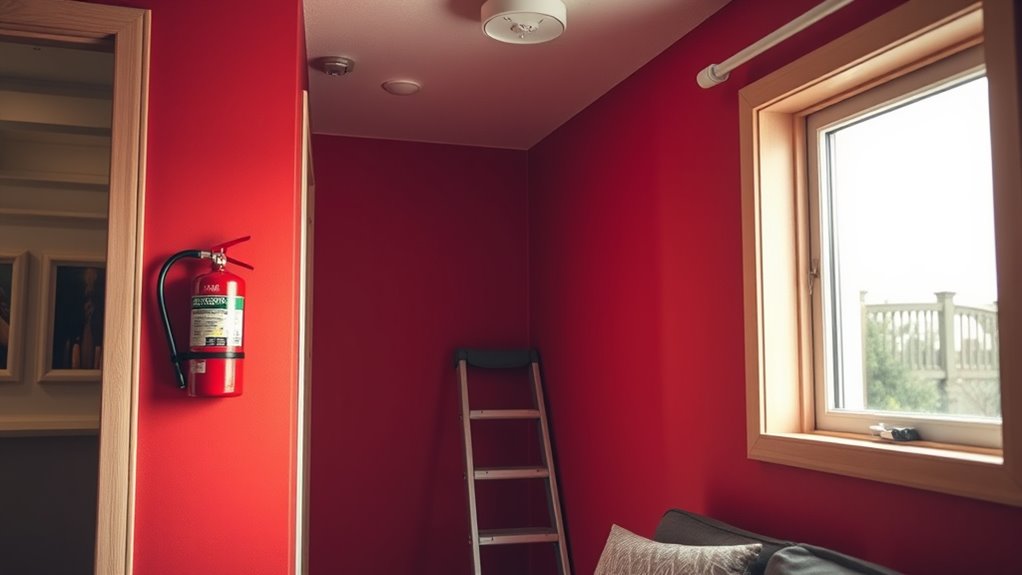To keep your small home safe from fires, regularly test your smoke alarms and change batteries at least once a year. Create and practice clear escape plans, making sure all household members know two exits from each room. Keep flammable items away from heat sources and never leave cooking unattended. Install safety equipment like fire extinguishers in key areas and stay vigilant about electrical overloads. Keep these tips in mind to protect your home—there’s more you can do to stay prepared.
Key Takeaways
- Install smoke detectors in all sleeping areas and kitchens, and test them monthly for proper function.
- Keep escape routes clear, identify two exits per room, and practice regular fire drills with household members.
- Avoid overloading outlets, keep flammable items away from heat sources, and never leave cooking unattended.
- Maintain fire alarms and replace batteries at least once a year for early fire detection.
- Keep a fire extinguisher accessible, especially in the kitchen, and learn how to properly use it.

Living in a small home means every corner counts when it comes to fire safety. Since space is limited, you need to be extra vigilant about protecting yourself and your loved ones. One of the most critical steps is ensuring your fire alarm system is in top shape. Regular fire alarm maintenance is essential; test your alarms monthly to verify they’re working properly, and change the batteries at least once a year or as recommended by the manufacturer. If your alarms are interconnected, make sure they’re all functioning correctly so that a fire in one area triggers an alert throughout your home. This quick detection can give you precious extra seconds to react and evacuate safely.
Having a well-thought-out escape plan is equally essential in small homes. Because space is tight, you often have fewer routes to safety, so planning escape strategies becomes even more important. Identify two exits from every room, such as a door and a window, and make sure these pathways are always clear of clutter. Practice your escape plan regularly, especially with children or elderly family members, so everyone knows what to do when seconds matter. Keep emergency contact numbers posted near exits, and consider installing escape ladders if you’re on an upper floor. Remember, the goal is to get out quickly and safely without hesitation.
Create a clear escape plan with two exits per room and practice regularly for quick, safe evacuation.
In addition to alarms and escape plans, consider other safety measures tailored to small spaces. Installing smoke detectors in every sleeping area and the kitchen is non-negotiable. Since small homes tend to have open floor plans, a fire in one area can quickly spread, making early detection even more critical. Keep a fire extinguisher accessible, particularly in the kitchen, and learn how to use it properly. Small homes often have limited storage, so choose compact, multi-purpose safety equipment that doesn’t take up unnecessary space but still provides reliable protection.
Finally, be mindful of fire hazards specific to small living environments. Avoid overcrowding electrical outlets, never leave cooking unattended, and keep flammable items away from heat sources. Regular fire alarm maintenance is crucial, as it ensures your detection systems are always ready to alert you at the first sign of danger. Combining diligent fire alarm maintenance with effective escape plan strategies creates a safety net that minimizes risks and maximizes your chances of avoiding disaster. In a small home, safety isn’t just about prevention; it’s about being prepared and quick to act. With these steps in place, you can confidently enjoy your cozy space, knowing you’re protected against potential fires.
Frequently Asked Questions
How Often Should Fire Alarms Be Tested in Small Homes?
You should test your fire alarms at least once a month to verify they’re working properly. During alarm maintenance, press the test button and listen for the loud alarm. If your alarms run on batteries, replace the batteries annually or whenever you hear a low-battery chirp. Regular testing and battery replacement keep your alarms reliable, helping you stay safe and prepared in case of a fire emergency.
Are There Specific Fire Safety Regulations for Small Homes?
In the age of chivalry, fire safety regulations for small homes are quite specific. You should follow local building codes that cover fire prevention measures, such as smoke alarm placement, escape routes, and electrical safety. While there aren’t unique rules for small homes, adherence ensures safety. Always check with your local authorities, as regulations can vary, and staying updated helps you prevent fire hazards effectively.
What Is the Best Fire Extinguisher for Small Spaces?
The best fire extinguisher for small spaces is a multi-purpose portable fire extinguisher, typically an ABC type. These extinguishers handle common fires like electrical, paper, and cooking fires effectively. You should choose a compact size, such as a 2.5-pound model, that’s easy to store and access quickly. Make certain it’s rated for multiple fire types and regularly check its pressure to guarantee it’s ready when needed.
How Can I Create an Escape Plan for My Small Home?
Who knew planning an escape route could be so fun? Start by walking through your small home, identifying two exits from each room. Sketch a simple map for easy reference, emphasizing clear escape routes. Practice your plan regularly with family, and always keep an emergency kit nearby. Remember, a little planning now can save lives later—so don’t wait until it’s too late to create an effective escape plan.
Should I Install Smoke Detectors Outside Bedrooms?
Yes, you should install smoke detectors outside bedrooms to enhance fire prevention and guarantee early warning. Place detectors in hallways and near sleeping areas for maximum safety. Combine this with emergency lighting to help you navigate safely during a fire. Regularly test your smoke detectors and replace batteries to keep them functioning. This proactive approach improves your overall fire safety and helps protect everyone in your small home.
Conclusion
While your small home may feel cozy and manageable, remember that fire safety requires just as much attention as a larger space. Think of fire prevention as both your biggest challenge and your greatest protector—like a vigilant guardian watching over your belongings. By staying alert and prepared, you turn your tiny haven into a safe sanctuary. After all, in a small space, a single spark can make a big difference—so stay cautious, stay safe.








